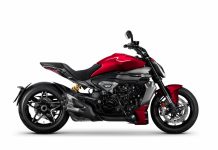Aerodynamics has come to define MotoGP’s current era. Even as rivals pour more resources into research and development, Ducati continues to lead the way. We look at how the category has evolved and where future growth is headed.
Aerodynamics
Aerodynamics is the study of how air interacts with objects. All Moto GP bikes use a conventional motorcycle engine, gearbox and chassis to accommodate their specific aerodynamic components.
Ducati has the most advanced aerodynamic package in its Desmosedici bike, which includes many different components, including rear suspension, integrated rear-winglets and more.
Each motorcycle’s aerodynamics in MotoGP is essential because they provide extra downforce. According to Ducati, they can also use them to shape the airflow around the bike and reduce drag.
The brand debuted its aerodynamics package during pre-season testing in 2015, followed by Honda, Aprilia, Yamaha and Suzuki soon followed suit before revising their designs with even more aggressive aerodynamic appendages — most notably Yamaha’s winglets.
The elements
The Ducati Desmosedici GP22 has been through an extensive aerodynamic redesign. At first sight, it may seem like the primary function of the new front fairing is to generate some additional downforce.
But this is only part of the picture, and many aerodynamic elements are hidden within the bodywork. While on a straight track, most of these aerodynamic elements do not contribute much. In turn, these can be the difference between a good and a bad lap time.
Aerodynamic elements are common throughout the motorcycle world, so it’s worth looking at how they have evolved throughout MotoGP’s history.
Most are found in the region between the rider and rear tire, effectively generating downforce for improved handling. Recently, many of these aerodynamic pieces have been detuned to reduce sky-high cornering speeds, which could reach 200 km/h in a straight line during qualifying.

Ducati brings their “Stegosaurus winglets” at the British Grand Prix on August 5, 2022.
High-tech marvels
The bikes in MotoGP have always been high-tech marvels. Squeezed between a rider’s knees and limited by the racing rules, the aerodynamics of a MotoGP bike is crucial to success.
Aerodynamics has evolved significantly throughout Grand Prix’s sixty-year history. The earliest bikes had basic fairings with flat or curved windshields. By the late 60s, rear wheel “spoons” became commonplace. At the time, they were seen as an advantage and played a crucial role in developing tire warmers in racing pit stops.
Today, they help keep tires cool and slipstream air into brake cooling ducts. Calliper air scoops are also strategically located around key braking components and nestle directly below levers to aid in cooling.
Braking performance is critical to keeping riders out of trouble during race days because it slows individual lap times and allows the rider some predictability when they enter the race’s faster sections.
Winglets
Winglets are a small but essential part of every MotoGP bike. They improve the bike’s aerodynamics, which can generate more grip when the rider leans into a corner. Winglets effectively allow the front tire to “stick” to the track surface. While this is helpful in all weather conditions, it is essential when a clean line is far harder to come by in wet conditions.
And we could see Ducati and Aprilia launch new tail-mounted aerodynamic winglets in 2022 on their MotoGP bikes.
Aprilia was the first to introduce them to the Italian Grand Prix on May 27, 2022. Ducati followed them with their “Stegosaurus winglets” at the British Grand Prix on August 5, 2022.

Aprilia was the first to introduce a tail spoiler in the Italian Grand Prix on May 27, 2022
Marketing
Not only do MotoGP’s wings serve an aerodynamic purpose, but they also act as a visual branding for the respective manufacturers. If a wing is particularly effective and beautiful in its design, the sponsor logos adorning it stand out even more.
Suppose they thought of putting their logos on them. When the sport opened its doors to winglets, it was evident that winglet design would soon become something of a “spec war” inside the engineering departments of the factories.
Sporting the most aerodynamic package in the MotoGP class has gained much attention for Ducati and Aprilia over the past couple of years. It’s one thing to have a flashy new bike win a race, but it’s far rarer to have that easy-to-spot distinction translate into actual performance gains.
Future
As racing continues to evolve, so do its aerodynamic components. Some say a bike’s aerodynamics are more important than its power-to-weight ratio– a competitive advantage that keeps manufacturers engaged in a relentless quest for more incredible performance throughout the decades.
As technologies have evolved and motorcycles have become more sophisticated, they have also adopted more advanced aerodynamic designs. This has helped refine their overall performance, turning races into highly entertaining events for fans.
Ultimately, regardless of your favourite motorcycle brand, aerodynamics will continue to be an essential part of racing and design moving into the future.

































